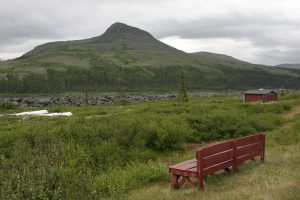JBNQA AND NEQA
Origin

At the beginning of the 1970’s, the gouvernement du Québec planned to develop the hydro-electric potential of James Bay, but the Crees of James Bay and the Inuit of Northern Québec opposed. Consequently, the parties undertook negotiations aimed at organizing development of the territory and planning for the use of natural resources.
The November 11th, 1975 signing of the James Bay and Northern Québec Agreement (JBNQA) between the gouvernement du Québec, the government of Canada, the Crees of James Bay and the Inuit of Northern Québec was the culmination of these negotiations. The JBNQA is the first modern land claim agreement in Canada. On January 31st, 1978, the Naskapis signed the Northeastern Québec Agreement (NEQA) and joined the Hunting, Fishing and Trapping Coordinating Committee.
Signatories of the James Bay and Northern Québec Agreement on November 11th, 1975:
– The Grand Council of the Crees (of Québec)
– The Northern Québec Inuit Association
– Le gouvernement du Québec
– La Société d’énergie de la Baie James
– La Société de développement de la Baie-James
– La Commission hydroélectrique de Québec (Hydro-Québec)
– Le gouvernement du Canada
Signatories of the Northeastern Québec Agreement on January 31st, 1978:
– The Naskapis de Schefferville Band
– Le gouvernement du Québec
– La Société d’énergie de la Baie James
– La Société de développement de la Baie James
– La Commission hydroélectrique de Québec (Hydro-Québec)
– The Grand Council of the Crees (of Québec)
– The Northern Québec Inuit Association
– Le gouvernement du Canada
Territorial Divisions and Exclusive Rights
The Territory under the JBNQA and the NEQA covers an area of 1,082,000 km2 on the northern regions of Québec, and corresponds to the lands transferred to Québec by the 1898 and the 1912 Acts extending and delineating the boundaries of Québec.
Section 24 of the James Bay and Northern Agreement (JBNQA) as well as the Act respecting hunting and fishing rights in the James Bay and New Québec territories divides the Territory under JBNQA and NEQA into three areas (northern, buffer and southern) with regards to the application of the Hunting, Fishing and Trapping Regime and the act. On the whole, the provisions of the regime and the act apply fully in the northern area (north of 50th parallel), with some restrictions in the buffer area, and do not apply in the southern area, except in the case of category I and II lands and on Cree traplines.
Section 5 (for the Crees) and Section 7 (for the Inuit) of the JBNQA, Section 5 of the NEQA, and the Act respecting the land regime in the James Bay and New Québec territories establish a Land Regime dividing the Territory under the JBNQA and the NEQA into three land categories (I, II, and III) with attached usage, ownership and administrative rights. The rights, boundaries and surface areas of these land categories are also provided for.

- Exclusive Hunting, Fishing and Trapping Rights
On Category I and II lands (approximately 1% and 14% of the Territory, respectively), Inuit and Cree beneficiaries of the JBNQA and Naskapi beneficiaries of the NEQA possess exclusive hunting, fishing and trapping rights. Non-beneficiaries may obtain permission to hunt or fish from local Cree, Inuit or Naskapi authorities. Non-beneficiaries do not have the right to trap.
On Category III lands (approximately 85% of the Territory), beneficiaries (Inuit, Crees and Naskapis) and non-beneficiaries have the right to hunt and fish, but beneficiaries have exclusive rights for trapping.
- Areas of Primary and Common Interest
Section 24 of the James Bay and Northern Québec Agreement (JBNQA) and Section 15 of the Northeastern Québec Agreement (NEQA) define the respective rights of the Inuit, Crees and Naskapis in portions of the Territory under the JBNQA and the NEQA, known “Areas of Primary and Common Interest”.

